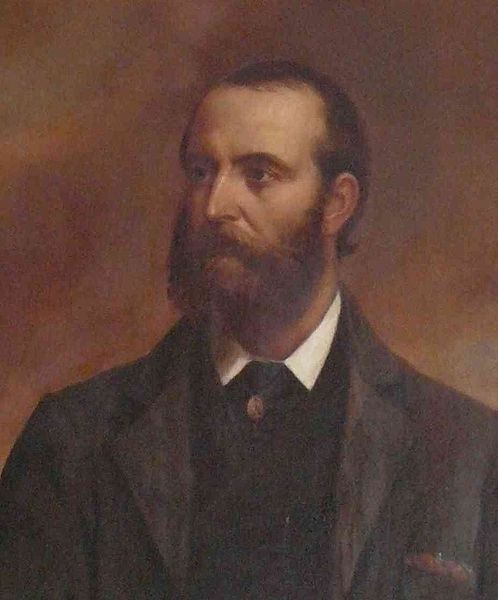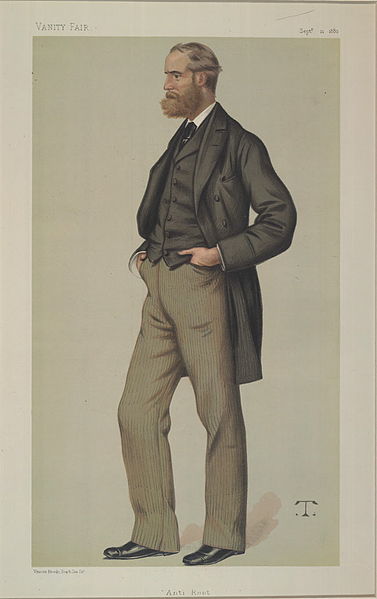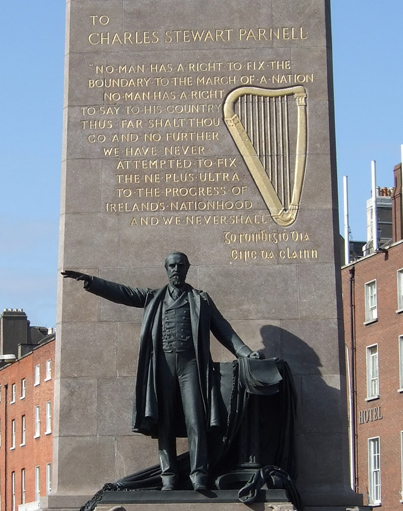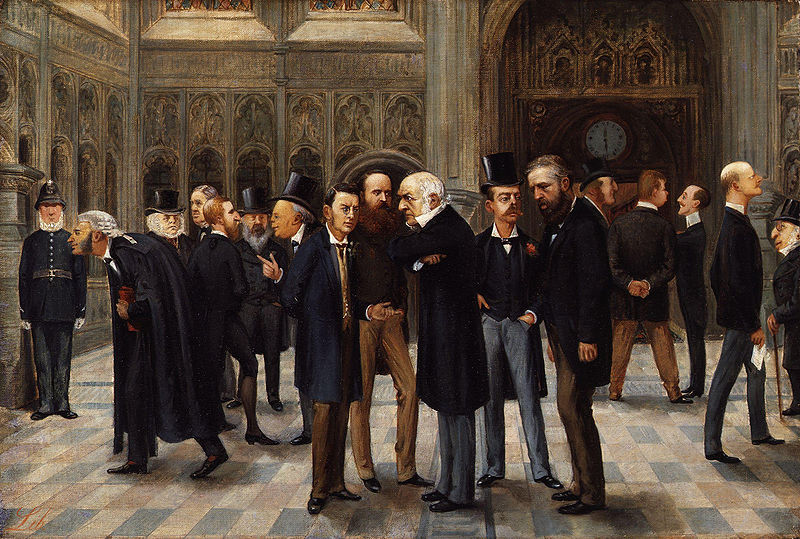<Back to Index>
- Anarchist Philosopher and Activist Emma Goldman, 1869
- Writer and Political Activist Helen Adams Keller, 1880
- Founder of the Irish Parliamentary Party Charles Stewart Parnell, 1846
PAGE SPONSOR
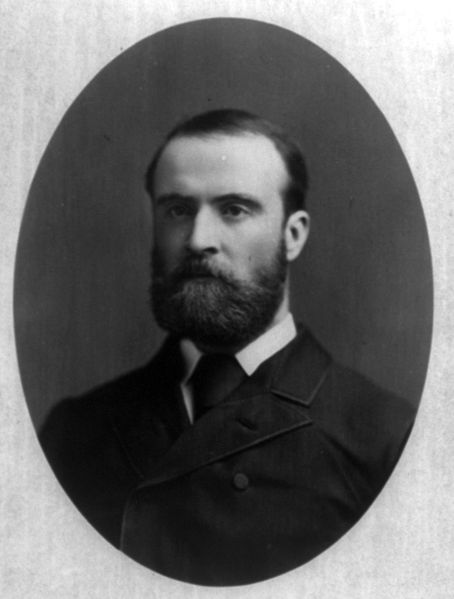
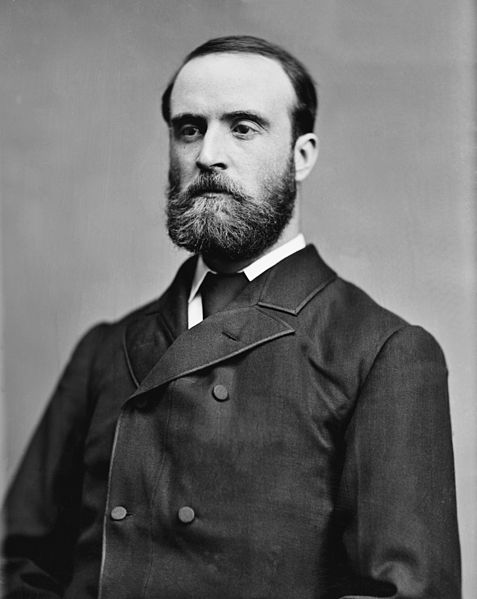
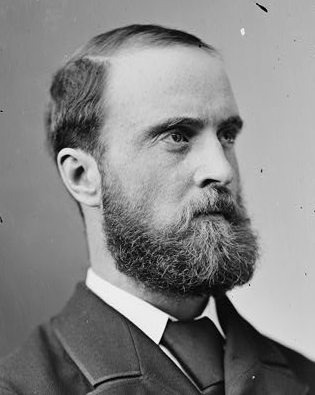
Charles Stewart Parnell (27 June 1846 – 6 October 1891) was an Irish landowner, nationalist political leader, land reform agitator, and the founder and leader of the Irish Parliamentary Party. He was one of the most important figures in 19th century Ireland and Great Britain, and was described by Prime Minister William Gladstone as the most remarkable person he had ever met.
Parnell led the Irish Parliamentary Party as Member of Parliament (MP) through the period of Parliamentary nationalism in Ireland between 1875 and his death in 1891. Future Liberal Prime Minister, H.H. Asquith, described him as one of the three or four greatest men of the 19th century, while Lord Haldane described him as the strongest man the British House of Commons had seen in 150 years. The Irish Parliamentary Party split during 1890,
following revelations of Parnell's private life intruding on his political career. He is nevertheless revered by subsequent Irish parliamentary republicans and nationalists. Charles Stewart Parnell was born in County Wicklow, of Protestant gentry stock. He was the third son and seventh child of John Henry Parnell (1811 – 1859), wealthy Anglo - Irish landowner, and his American wife Delia Tudor Stewart (1816 – 1898) of Bordentown, New Jersey, daughter of the American naval hero, Admiral Charles Stewart (1778 - 1869) (the stepson of one of George Washington's
bodyguards). There were eleven children in all: five boys and six
girls. Admiral Stewart's mother, Parnell's great - grandmother, belonged
to the Tudor family so had a distant relationship with the British Royal Family. John Henry Parnell himself was a cousin of one of Ireland's leading aristocrats, Viscount Powerscourt, and also the grandson of a Chancellor of the Exchequer in Grattan’s Parliament, Sir John Parnell, who lost office in 1799 when he opposed the Act of Union. The Parnells of Avondale were descended from an English merchant family, which came to prominence in Congleton, Cheshire, early in the 17th century where as Baron Congleton two
generations held the office of Mayor of Congleton before moving to
Ireland. The family produced a number of notable figures, including Thomas Parnell (1679 – 1718), the Irish poet and Henry Parnell, 1st Baron Congleton (1776 – 1842)
the Irish politician. Parnell's grandfather William Parnell
(1780 – 1821), who inherited the Avondale Estate in 1795, was a liberal
Irish MP for Wicklow from
1817 – 1820. Thus, from birth, Charles Stewart Parnell possessed an
extraordinary number of links to many elements of society; he was
linked to the old Irish Parliamentary tradition via his
great - grandfather and grandfather, to the American War of Independencevia his grandfather, to the War of 1812 (where his grandfather had been awarded a gold medal by the United States Congress for gallantry); he belonged to the disestablished Church of Ireland (its members mostly unionists) though in later years he was to drop away from formal church attendance; he
was connected with the aristocracy through the Powerscourts and
distantly connected to the Royal Family. Yet it was as a leader of Irish Nationalism that Parnell established his fame. Parnell's
parents separated when he was six, and as a boy he was sent to
different schools in England, where he spent an unhappy youth. His
father died in 1859 and he inherited the Avondale estate. The young
Parnell studied at Magdalene College, Cambridge (1865 – 69)
but, due to the troubled financial circumstances of the estate he
inherited, he was absent a great deal and never completed his degree. In 1871, he joined his elder brother John Howard Parnell (1843 – 1923), who farmed in Alabama (later an Irish Parnellite MP and heir to the Avondale estate), on an extended tour of the United States. Their travels took them mostly through the South and apparently the brothers neither spent much time in centres of Irish immigration nor sought out Irish - Americans. In 1874, he became High Sheriff of Wicklow,
his home county in which he was also an officer in the Wicklow militia.
He was noted as an improving landowner who played an important part in
opening the south Wicklow area to industrialisation. Perhaps
due to lack of interest in other enterprises, his attention was drawn
to the theme dominating the Irish political scene of the mid 1870s, Isaac Butt’s Home Rule League formed
in 1873 to campaign for a moderate degree of self - government. It was in
support of this movement that Parnell first tried to stand for election
in Wicklow, but as high sheriff was disqualified. He failed again in
1874 as home rule candidate in a County Dublin by-election. Parnell was first elected to the House of Commons, as a Home Rule League Member of Parliament (MP) for County Meath on 21 April 1875 in a by-election backed by Fenian Patrick Egan. He replaced the deceased League MP, veteran Young Irelander John Martin. He subsequently sat for the constituency of Cork City from 1880 until 1891. During
his first year Parnell remained a reserved observer of parliamentary
proceedings. He first came to attention in the public eye when in 1876
he claimed in the Commons that he did not believe that any murder had
been committed by Fenians in Manchester. This drew the interest of the Irish Republican Brotherhood (IRB), a physical force Irish organisation that had staged a rebellion in 1867. Parnell made it his business to cultivate Fenian sentiments both in Britain and Ireland and became associated with the more radical wing of the Home Rule League, which included Joseph Biggar (MP for Cavan from 1874), John O'Connor Power (MP for County Mayo from 1874) (both, although constitutionalists, had links with the IRB), Edmund Dwyer - Gray (MP for Tipperary from 1877), and Frank Hugh O'Donnell (MP for Dungarvan from 1877). He engaged with them and played a leading role in a policy of obstructionism (i.e.,
the use of technical procedures to disrupt the House of Commons'
ability to function) to force the House to pay more attention to Irish
issues, which had previously been ignored. Obstruction involved giving
lengthy speeches which were largely irrelevant to the topic at hand.
This behaviour was opposed by the less aggressive chairman (leader) of
the Home Rule League, Isaac Butt. Parnell
visited America that year accompanied by O'Connor Power. The question
of his closeness to the IRB, and whether indeed he ever joined the
organisation, has been a matter of academic debate for a century. The
evidence suggests that later, following the signing of the Kilmainham Treaty, Parnell did take the IRB oath, possibly for tactical reasons. What
is known is that IRB involvement in the League's sister organisation,
the ‘’Home Rule Confederation of Great Britain’’, led to the moderate
Butt's ousting from its presidency (even though he had founded the
organisation) and the election of Parnell in his place on 28 August 1877. Parnell
was a restrained speaker in the House but his organisational,
analytical and tactical skills earned wide praise, enabling him to take
on the British organisation's presidency. Butt died in 1879 and was
replaced as chairman of the Home Rule League by the Whig oriented William Shaw. Shaw's victory was temporary, however. From August 1877 Parnell held a number of private meetings with prominent Fenian leaders. He visited Paris where he met John O'Leary and J.J. O'Kelly both of whom were impressed by him and reported positively to the most capable and militant Leader of the American republican Clan na Gael organisation, John Devoy. In December at a reception for Michael Davitt on
his release from prison, he met William Carrol who assured him of Clan
na Gael's support in the struggle for Irish self - government. This led
to a meeting in March 1878 between influential constitutionalists,
Parnell and Frank Hugh O'Donnell, and leading Fenians O'Kelly, O'Leary
and Carroll. This was followed by a telegram from John Devoy in October 1878 which offered Parnell a "New Departure"
deal of separating militancy from the constitutional movement as a path
to all - Ireland self - government, under certain conditions: abandonment
of a federal solution in favour of separatist self - government, vigorous
agitation in the land question on the basis of peasant proprietorship,
exclusion of all sectarian issues, collective voting by party members
and energetic resistance to coercive legislation. Parnell
preferred to keep all options open without clearly committing himself
when he spoke in 1879 before Irish Tenant Defence Associations at Ballinasloe and Tralee. It was not until Davitt persuaded him to address a second meeting at Westport, County Mayo in June that he began to grasp the potential of the land reform movement.
At a national level several approaches were made which eventually
produced the 'New Departure' of June 1879, endorsing the foregone
informal agreement which asserted an understanding binding them to
mutual support and a shared political agenda. In addition, the 'New
Departure' asserted the integrity of the Fenian movement and its armed
strategies.Working together with Davitt who was impressed by Parnell, he now took on the role of leader of the New Departure, holding platform meeting after platform meeting around the country. Throughout
the autumn of 1879, he repeated the message to tenants after the long
depression had left them without income for rent: You
must show the landlord that you intend to keep a firm grip on your
homesteads and lands. You must not allow yourselves be dispossessed as
you were dispossessed in 1847. He was elected president of Davitt's newly founded Irish National Land League in Dublin on 21 October 1879, signing a militant Land League address campaigning for land reform. At the age of 32 and after just over four years in parliament he had put into place a political coalition without precedent in Irish politics. He was elected president of Davitt's newly founded Irish National Land League in Dublin on 21 October 1879, signing a militant Land League address campaigning for land reform. In so doing, he linked the mass movement to the parliamentary agitation, with profound consequences for both of them. Andrew Kettle, his 'right - hand man', became honorary secretary. In a bout of activity, he left for America in December 1879 with John Dillon to raise funds for famine relief and secure support for Home Rule. Timothy Healy followed to cope with the press and they collected £70,000 for distress in Ireland. During Parnell's highly successful tour, he had an audience with American President Rutherford B. Hayes, on 2 February 1880 he addressed the House of Representatives on the state of Ireland and spoke in 62 cities including in Canada, where he was so well received in Toronto that Healy dubbed him "the uncrowned king of Ireland". (The same term was applied 30 years earlier to Daniel O'Connell.) He strove to retain Fenian support but insisted when asked by a reporter that he personally could not join a secret society. Central
to his whole approach to politics was ambiguity in that he allowed his
hearers to remain uncertain. During his tour, he seemed to be saying
that there were virtually no limits. To abolish landlordism, he asserted, would be to undermine English misgovernment, and he is alleged to have added: When
we have undermined English misgovernment we have paved the way for
Ireland to take her place amongst the nations of the earth. And let us
not forget that that is the ultimate goal at which all we Irishmen aim.
None of us whether we be in America or in Ireland ... will be satisfied
until we have destroyed the last link which keeps Ireland bound to
England. His activities came to an abrupt end when the United Kingdom general election, 1880 was announced for April and he returned to fight it. The Conservatives were defeated by the Liberal Party; William Gladstone was
again Prime Minister. Sixty - three Home Rulers were elected, including
twenty - seven Parnell supporters, Parnell being returned for three seats: Cork City, Mayo and Meath.
He chose to sit for the Cork seat. His triumph facilitated his
nomination in May in place of Shaw as leader of a new Home Rule League
Party, faced with a country on the brink of a land war. Although the League discouraged violence, agrarian outrages grew widely from 863 incidents in 1879 to 2,590 in 1880 after
evictions increased from 1,238 to 2,110 in the same period. Parnell saw
the need to replace violent agitation with country wide mass meetings
and the application of Davitt's boycott,
also as a means of achieving his objective of self - government.
Gladstone was alarmed at the power of the Land League at the end of
1880. He attempted to defuse the land question with dual ownership in the Second Land Act of 1881, establishing a Land Commission that reduced rents and enabled some tenants to buy their farms. These halted arbitrary evictions, but not where rent was unpaid. Parnell's own newspaper, the United Ireland, attacked the Land Act and he was arrested on 13 October 1881 together with his party lieutenants, William O'Brien, John Dillon, Michael Davitt and Willie Redmond, who had also conducted a bitter verbal offensive. They were imprisoned under a proclaimed Coercion Act in Kilmainham Gaol for "sabotaging the Land Act", from where the No-Rent Manifesto, which Parnell and the others signed, was issued calling for a national tenant farmer rent strike. The Land League was suppressed immediately. Whilst in gaol, Parnell moved in April 1882 to make a deal with the government, negotiated through Captain William O'Shea MP,
that, provided the government settled the "rent arrears" question
allowing 100,000 tenants to appeal for fair rent before the land
courts, then withdrawing the manifesto and undertaking to move against
agrarian crime, after he realised militancy would never win Home Rule.
His release on the 2nd of May following the so-called Kilmainham Treaty marked
a critical turning point in the development of Parnell’s leadership
when he returned to the parameters of parliamentary and constitutional
politics, and
resulted in the loss of support of Devoy's American - Irish. However, his
political diplomacy preserved the national Home Rule movement after the Phoenix Park Murders of the Chief Secretary Lord Cavendish, and his Under - Secretary, T.H. Burke on 6 May. Parnell was shocked to the extent that he offered Gladstone to resign his seat as MP. The militant Invincibles responsible
fled to America, which allowed him to break links with radical Land
Leaguers. In the end, it resulted in a Parnell – Gladstone alliance
working closely together. Davitt and other prominent members left the
IRB and many rank and file Fenians drifted into the Home Rule movement.
For the next 20 years, the IRB ceased to be an important force in Irish
politics, leaving Parnell and his party the leaders of the nationalist movement in Ireland.
Parnell
now sought to use his experience and huge support to advance his
pursuit of Home Rule and resurrected the suppressed Land League on 17
October 1882 as the
Irish National League (INL).
It combined moderate agrarianism, a Home Rule programme with electoral
functions, was hierarchical and autocratic in structure with Parnell
wielding immense authority and direct parliamentary control. Parliamentary
constitutionalism was the future path. The informal alliance between
the new, tightly disciplined INL and the Catholic Church was one of the
main factors for the revitalisation of the national Home Rule cause
after 1882. Parnell saw that the explicit endorsement of Catholicism
was of vital importance to the success of this venture and worked in
close co-operation with the Catholic hierarchy in consolidating its
hold over the Irish electorate. The
leaders of the Catholic Church largely recognised the Parnellite party
as guardians of church interests, despite uneasiness with a powerful
lay leadership. At the end of 1885, the highly centralised organisation had 1,200 branches spread around the country, though less in Ulster. Parnell left the day - to - day running of the INL in the hands of his lieutenants Timothy Harrington as Secretary, William O’Brien, editor of its newspaper United Ireland, and Timothy Healy. Its continued agrarian agitation led to the passing of several Irish Land Acts that over three decades changed the face of Irish land ownership, replacing large Anglo - Irish estates with tenant ownership. Parnell
next turned to the Home Rule League Party, of which he was to remain
the re-elected leader for over a decade, spending most of his time at
Westminster, with Henry Campbell as
his personal secretary. He fundamentally changed the party, replicated
the INL structure within it and created a well organised grass roots
structure, introduced membership to replace "ad hoc" informal groupings
in which MPs with little commitment to the party voted differently on
issues, often against their own party. Or
they simply did not attend the House of Commons at all (some citing
expense, given that MPs were unpaid until 1911 and the journey to Westminster both costly and arduous). In 1882, he changed his party's name to the Irish Parliamentary Party (IPP).
A central aspect of Parnell's reforms was a new selection procedure to
ensure the professional selection of party candidates committed to
taking their seats. In 1884, he imposed a firm 'party pledge' which
obliged party MPs to vote as a bloc in parliament on all occasions. The
creation of a strict party whip and
formal party structure was unique in party politics at the time. The
Irish Parliamentary Party is generally seen as the first modern British
political party, its efficient structure and control contrasting with
the loose rules and flexible informality found in the main British
parties, which came to model themselves on the Parnellite model. The Representation of the People Act 1884 enlarged the franchise, and the IPP increased its number of MPs from 63 to 85 in the 1885 election. The changes affected the nature of candidates chosen. Under Butt, the party's MPs were a mixture of Catholic and Protestant, landlord and others, Whig, Liberal and Tory,
often leading to disagreements in policy that meant that MPs split in
votes. Under Parnell, the number of Protestant and landlord MPs
dwindled, as did the number of Tories seeking election. The
parliamentary party became much more Catholic and middle class, with a large number of journalists and lawyers elected and the disappearance of Protestant Ascendancy landowners and Tories from it. Parnell's party emerged swiftly as a tightly disciplined and, on the whole, energetic body of parliamentarians. By
1885, he was leading a party well poised for the next general election,
his statements on Home Rule designed to secure the widest possible
support. Speaking in Cork on 21 January 1885, he stated: We cannot ask the British constitution for more than the restitution of Grattan's parliament, but no man has the right to fix the boundary of a nation. When Gladstone's government fell in June 1885, the delayed November general elections (boundaries
were being redrawn after the Third Reform Act) brought about a hung
Parliament, with a Parnellite bloc of 86 Irish Home Rule MPs holding
the balance of power in the Commons. Parnell's task was now to win
acceptance of the principle of a Dublin parliament. Both UK parties
toyed with various suggestions for greater self - government for Ireland,
such as a Central Board with powers similar to those of a County
Council. Parnell at first supported a Conservative government
- they were still the smaller party after the elections - but after
renewed agrarian distress arose when agricultural prices fell and
unrest developed during 1885, the Conservative government announced
coercion measures in January 1886. Parnell switched his support to the
Liberals. The
Liberals regained power, their leader Gladstone - influenced by the
status of Norway, which at the time was self - governing but under the
Swedish Crown - moving towards Home Rule, which Gladstone’s son
revealed publicly under what became known as the "flying of the Hawarden Kite". The prospects shocked Unionists. The Orange Order, revived in the 1880s to oppose the Land League now openly opposed Home Rule. On 20 January, the Irish Unionist Party was established in Dublin. By 28 January, Salisbury's government had resigned. Gladstone
formed his third government, committing his party to support the cause
of Irish Home Rule, but was unable to obtain the support of several key
players in his own party. The Whig leader Lord Hartington (who had been
Liberal leader in the late 1870s and was still the most likely
alternative leader) refused to serve at all, while the Radical Joseph Chamberlain briefly held office then resigned when he saw the terms of the proposed bill. On 8 April 1886, Gladstone introduced the First Irish Home Rule Bill,
his object to establish an Irish legislature, although large imperial issues were to be reserved to the Westminster parliament. The Conservatives now emerged as enthusiastic unionists, Lord Randolph Churchill declared, "The Orange card is the one to play". In the course of a long and fierce debate Gladstone made a remarkable Home Rule Speech,
beseeching parliament to pass the bill. However, the split between pro-
and anti - home rulers within the Liberal Party caused the defeat of the
bill on its second reading in June by 341 to 311 votes. Parliament was dissolved and elections called, with Irish Home Rule the central issue. Gladstone hoped to repeat his triumph of 1868,
when he had won a General Election on the topic of Irish
Disestablishment (which had been a major cause of dispute between
Conservatives and Liberals since the 1830s), but the result of the July 1886 general election was Liberal defeat. The Conservatives and the Liberal Unionist Party returned
with a majority of 118 over the combined Gladstonian Liberals and
Parnell's 85 Irish Party seats. Salisbury formed his second government
- a minority Conservative government with Liberal Unionist support. The
Liberal split made the Unionists (the Liberal Unionists sat in
coalition with the Conservatives after 1895 and would eventually merge
with them) the dominant force in British politics until 1906, with strong support in Lancashire, Liverpool & Manchester, Birmingham (the fiefdom of its former mayor Joseph Chamberlain who as recently as 1885 had
been a furious enemy of the Conservatives) and the House of Lords where
many Whigs sat (a second Home Rule Bill would pass the Commons in 1893
only to be overwhelmingly defeated in the Lords). Parnell
next became the centre of public attention when in March and April 1887
he found himself accused by the British newspaper The Times of supporting the brutal murders in May 1882 of the newly appointed Chief Secretary for Ireland, Lord Frederick Cavendish and the Permanent Under - Secretary, Thomas Henry Burke in Dublin's Phoenix Park, and of the general involvement of his movement with crime (i.e., with illegal organisations such as the IRB).
Letters were published which suggested Parnell was complicit in the
murders. The most important one, dated 15 May 1882, ran as follows: Dear
Sir, – I am not surprised at your friend's anger, but he and you should
know that to denounce the murders was the only course open to us. To do
that promptly was plainly our best policy. But you can tell him, and
all others concerned, that, though I regret the accident of Lord
Frederick Cavendish's death, I cannot refuse to admit that Burke got no
more than his deserts. You are at liberty to show him this, and others
whom you can trust also, but let not my address be known. He can write
to House of Commons. Yours very truly, Chas S. Parnell. However, a Commission of Enquiry, which Parnell had requested, revealed in February 1889 after 128 sessions that the letters were a fabrication created by Richard Pigott,
a disreputable anti - Parnellite rogue journalist. Pigott broke down
under cross - examination after the letter was showed to be a forgery by
him with his characteristic spelling mistakes. He fled to Madrid where he committed suicide. Parnell was vindicated, to the disappointment of the Tories and the Prime Minister, Lord Salisbury. The
35 volume commission report published in February 1890, did not however
clear Parnell's movement of criminal involvement. Parnell then took The Times to
court and the newspaper paid him £5,000 damages in an
out - of - court settlement. When Parnell entered parliament on 1 March
1890 after he was cleared, he received a standing ovation from his
fellow MPs led by Gladstone. It
had been a dangerous crisis in his career, yet Parnell had at all times
remained calm, relaxed and unperturbed which greatly impressed his
political friends. For while he was vindicated in triumph, links
between the Home Rule movement and militancy, had been established.
This he could have survived politically were it not for the crisis to
follow. During
the period 1886 – 90, Parnell continued to pursue Home Rule, striving to
reassure English voters that it would be of no threat to them. In
Ireland, unionist resistance (especially after the Irish Unionist Party
was formed) became increasingly organised. Parnell
pursued moderate and conciliatory tenant land purchase and still hoped
to retain a sizeable landlord support for home rule. During the
agrarian crisis, which intensified in 1886 and launched the Plan of Campaign organised by Parnell’s lieutenants, he chose in the interest of Home Rule not to associate himself with it. All
that remained, it seemed, was to work out details of a new home rule
bill with Gladstone. They held two meetings, one in March 1888 and a
second more significant meeting at Gladstone’s home in Hawarden on
18 – 19 December 1889. On each occasion, Parnell's demands were entirely
within the accepted parameters of Liberal thinking, Gladstone noting
that he was one of the best people he had known to deal with, a remarkable transition from an inmate at Kilmainham to an intimate at Hawarden in just over seven years. This
was the high point of Parnell's career. In the early part of 1890, he
still hoped to advance the situation on the land question, with which a
substantial section of his party was displeased. Parnell's leadership was first put to the test in February 1886 when he forced the candidature of Captain William O'Shea,
who had negotiated the Kilmainham Treaty, for a Galway seat
by-election. Parnell rode roughshod over his lieutenants Healy, Dillon
and O'Brien who were not in favour of O'Shea. Galway was the harbinger
of the fatal crisis to come. O'Shea had already separated from his wife Katharine O'Shea,
but would not divorce her as she was expecting a substantial
inheritance. Mrs. O'Shea acted as liaison in 1885 with Gladstone during
proposals for the First Home Rule Bill. Parnell later took up residence with her in Eltham, Kent in the summer of 1886, and was a known overnight visitor at the O'Shea house in Brockley, London. When Mrs O’Shea’s aunt died in 1899, her money was left in trust (later inherited by cousins). On
24 December 1889, Captain O'Shea filed for divorce, citing Parnell as
co-respondent, although the case did not come for trial until 15
November 1890. It was soon 'revealed' (though it had been widely known
among politicians at Westminster) that Parnell had been the long term
partner of Mrs O'Shea (also known derogatively as "Kitty") and had
fathered three of her children. Meanwhile,
Parnell assured the Irish Party that there was no need to fear the
verdict; he would be exonerated. During January 1890, resolutions of
confidence in his leadership were passed throughout the country. Parnell
did not contest the divorce case on 15 November to ensure that it would
be granted and he could marry Mrs O'Shea; so Captain O'Shea's
allegations went unchallenged. A divorce decree was granted on 17
November 1890 and Parnell's two children were placed in O'Shea's
custody (his first child having died when he was in Kilmainham Gaol).
The next day, the Irish National League passed a resolution upholding his leadership. The Catholic Church hierarchy in Ireland was largely silent, some bishops explicitly declaring the issue to be purely political, though
divorce is forbidden under Catholic doctrine and most of Parnell's
supporters were members of the Catholic Church. As co-respondent,
Parnell was legally the apparent cause of the divorce, so that it was
rather the 'nonconformist conscience' in England which openly rebelled against him, and resulted in Gladstone's warning, given to Justin McCarthy as
intermediary, that if Parnell retained leadership, it would mean the
loss of the next election, the end of their alliance and also of Home
Rule. When the annual party leadership election was held on 25
November, this threat was not conveyed to the members whom Parnell
managed to control, until they loyally re-elected their 'chief' in his
office. Gladstone
published his warning in a letter the next day; subsequently, angry
members demanded a new meeting, called for 1 December. Parnell issued a manifesto 'To
the people of Ireland' on 29 November saying a section of the party had
lost its independence, and Gladstone's terms for Home Rule were
inadequate. A total of 73 members were present for the fateful meeting
in committee room 15 at Westminster. The party tried desperately to
achieve a compromise, with Parnell retiring temporarily. But Parnell, a
proud and passionate man, refused, saying, "If I go, I go forever". He
vehemently insisted that the independence of the Irish party could not
be compromised either by Gladstone or by the Catholic hierarchy and,
as chairman, blocked any motion to remove him. On 6 December, after
five days of debating, a majority of 44 present led by Justin McCarthy
walked out to found a new organisation, thus creating rival Parnellite
and anti - Parnellite parties. The minority of 28 who remained true to
their embattled 'Chief' continued in the Irish National League under John Redmond, the vast majority of anti - Parnellites forming the Irish National Federation, later led by John Dillon and supported by the Catholic Church. During the meeting, Parnell had challenged Gladstone's intervention with the question, "Who is the master of the party?" Timothy Healy,
a notoriously waspish MP, responded with the quip, "Who is the mistress
of the party?" Parnell retorted, how dare he in an assembly of Irishmen
insult a woman. Healy
continued in public with a series of polemics viciously attacking
Parnell, articulating an aggressively Catholic nationalism. Parnell in
contrast had insisted in a major speech in Belfast in May 1891, It is undoubtedly true that until the prejudices of the Protestant and Unionist minority are conciliated ….. All
of his former close associates, Michael Davitt, John Dillon, William
O’Brien and Timothy Healy deserted him to join the anti - Parnellites.
The bitterness of the split was to tear the country apart and resonated
well into the next century. On 10 December, Parnell arrived in Dublin to a hero's welcome. He and his followers later forcibly seized the offices of the party paper United Irishman.
His prestige had risen to unprecedented heights, but the crisis
crippled this support, and most rural nationalists turned against him.
In the December North Kilkenny by-election, he attracted Fenian "hillside
men" to his side. This ambiguity shocked former adherents, who clashed
physically with his supporters, his candidate beaten by almost two to
one. Deposed
as leader, he fought a long and fierce campaign for re-instatement. He
conducted a political tour of Ireland to re-establish popular support.
In a North Sligo by-election, the defeat of his candidate by 2,493 votes to 3,261 was less resounding, the clergy not united. He fulfilled his loyalty to Katharine when they married on 25 June 1891 in Steyning Register Office, West Sussex,
after Parnell had unsuccessfully sought a church wedding. On the same
day, the Irish Catholic hierarchy, worried by the number of priests who
had supported him in North Sligo, signed and published a near unanimous
condemnation: "by his public misconduct, has utterly disqualified
himself to be … leader." Only Bishop Edward O'Dwyer of Limerick withheld his signature. The Parnells took up residence in Brighton. He returned to fight the third and last by-election in County Carlow, having lost the support of the Freeman's Journal when its proprietor Edmund Dwyer - Gray defected
to the anti - Parnellites. On the difficult campaign trail, his health
visibly worsened since Kilmainham Gaol and seriously deteriorating
during the year, quicklime was thrown at his eyes by a hostile crowd in Castlecomer, County Kilkenny. Fr. P.J. Ryan, a Land League protagonist, called in medical aid given by his brother, Dr Valentine Ryan of Carlow,
a Home Rule sympathiser. Parnell continued the exhausting life of an
Irish public agitator, refused to regard parliamentary pressure as
outmoded and looked to the next election to
restore his fortunes. On 27 September, rather than disappoint his
followers in the west, he addressed a crowd in pouring rain at Creggs on the Galway / Roscommon border, subjecting himself to a severe soaking. This was taking a great risk with his health, for Parnell was suffering from a serious kidney disease.
He
returned to Dublin, departing by mail boat on 30 September ("I shall be
all right. I shall be back next Saturday week."). He died in his home
at 10 Walsingham Terrace,
Hove (now replaced by Dorset Court, Kingsway) on 6 October 1891 of a heart attack and in the arms of his wife Katharine (formerly Katharine O'Shea). He was 45 years of age. Though an Anglican, his funeral at the Irish National nondenominational Glasnevin Cemetery in Dublin on 11 October was attended by more than 200,000 people. His notability was such that his gravestone of unhewn Wicklow granite, erected in 1940, reads only "Parnell". His brother John Howard inherited the Avondale estate. He found it heavily mortgaged and eventually sold it in 1899. Five years later, at the suggestion of Horace Plunkett it
was purchased by the state. It is open to public view and is where the
"Parnell Society" holds its annual August summer school. The "Parnell
National Memorial Park" is in nearby Rathdrum, County Wicklow. The capital city Dublin commemorated Parnell with the naming of Parnell Street and Parnell Square. At the north end of O'Connell Street stands the Parnell Monument. This was planned and organised by John Redmond, who chose the American Augustus Saint Gaudens to sculpt the statue, and which was eventually completed in 1911. He
is also commemorated on the first Sunday after the anniversary of his
death on October 6, known as "Ivy Day", which originated when the
mourners at his funeral in 1891, taking their cue from a wreath of ivy
sent by a Cork woman "as the best offering she could afford", took ivy
leaves from the walls and stuck them in their lapels. Ever after, the
ivy leaf became the Parnellite emblem, worn by his followers when then
gathered to honour their lost leader. Parnell's
personal political views remained an enigma. An effective communicator
he was skilfully ambivalent and matched his words depending on
circumstances and audience though he would always first defend
constitutionalism on which basis he sought to bring about change. But
he was hampered by the crimes that hung around the Land League, and by
the opposition of landlords aggravated by attacks on their property. Yet he condoned radical republican and atheist Charles Bradlaugh and associated with the Roman Catholic Church, was linked both with the landed aristocracy class and the Irish Republican Brotherhood,
with speculation in the 1890s that he may have even joined the latter
organisation. The historian Andrew Roberts argues that he was sworn
into the IRB in the Old Library at Trinity College Dublin in May 1882 and that this was concealed for 40 years. He
was conservative by nature, leading some historians to suggest that
personally he would have been closer to the Conservative rather than to
the Liberal Party, but for political needs. Andrew Kettle,
Parnell's right hand man, who shared a lot of his opinions, wrote of
his own views, "I confess that I felt [in 1885], and still feel, a
greater leaning towards the British Tory party than I ever could have
towards the so-called Liberals." Historians believe Parnell and Timothy Healy shared that viewpoint. In
later years, the double effect of the Phoenix Park trauma and the
O’Shea affair reinforced the conservative side of his nature.
Charles Stewart Parnell possessed the remarkable attribute of
charisma,
was an enigmatic personality, politically gifted and is regarded as one
of the most extraordinary figures in Irish and British politics. He
played a part in the process that undermined his own Anglo - Irish caste; within two decades absentee landlords were
almost unknown in Ireland. He created single handedly in the Irish
Party the first modern disciplined political party machine with its
whip, holding together all strands of Irish nationalism and harnessing
Irish - America into the Irish cause. He had the power to make and unmake
governments in the United Kingdom and converted the British Prime
Minister Gladstone to Irish Home Rule. Over
a century after his death he is still surrounded by public interest.
His death, and the divorce upheaval which preceded it, gave him a
public appeal and interest that other contemporaries, such as Timothy
Healy or John Dillon, could not match. Historians speculate as to
whether, had Parnell lived and home rule been granted a decade earlier,
All - Ireland independence could have, in time, flowed from such a
settlement and have meant there would have been no Easter Rising, no Anglo - Irish War, no independent twenty - six county Free State and no ensuing civil war. The enactment of All - Ireland independence could certainly only have taken place with the consent of all of Ulster, its inclusion in an All - Ireland parliament, at the time, a debatable issue. However, after Edward Carson the Ulster leader, backed by the Ulster Covenant and his armed Ulster Volunteers, forced through his amending "exclusion of Ulster Bill" to the 1914 Third Home Rule Act, and with the establishment of a Northern Ireland Home Rule Government in Belfast under the Government of Ireland Act 1920, Unionist opposition since 1885 to "All - Ireland independence" proved itself to be extremely resilient and steadfast. The scale of Parnell's impact can be seen in the fact that parties from Fianna Fáil and Fine Gael have
tried to claim him as "one of their own". The uniqueness of his appeal
was shown when, in the early 1890s two visiting members of the Royal Family, the Duke of Clarence and the Duke of York (later King George V), paid a private visit to the grave of the "uncrowned king of Ireland" in Glasnevin. Ultimately
the O'Shea divorce issue and Parnell's premature death changed the
shape of late 19th century politics, to an extent that can be but
speculated. He had been prepared to sacrifice everything for his love
to Mrs O'Shea, including the cause to which he had devoted his
political life. For generations of Irish people, his life as the "lost
leader" was highly dramatic and deeply tragic, against whose mythical
reputation no later leader who lived a normal lifespan and who faced
the practicalities of governance that Parnell never faced, could hope
to prevail.
No man has the right to say to his country, "Thus far shalt thou go and no further", and we have never attempted
to fix the "ne plus ultra" to the progress of Ireland’s nationhood, and we never shall.
Ireland can never enjoy perfect freedom, Ireland can never be united.
